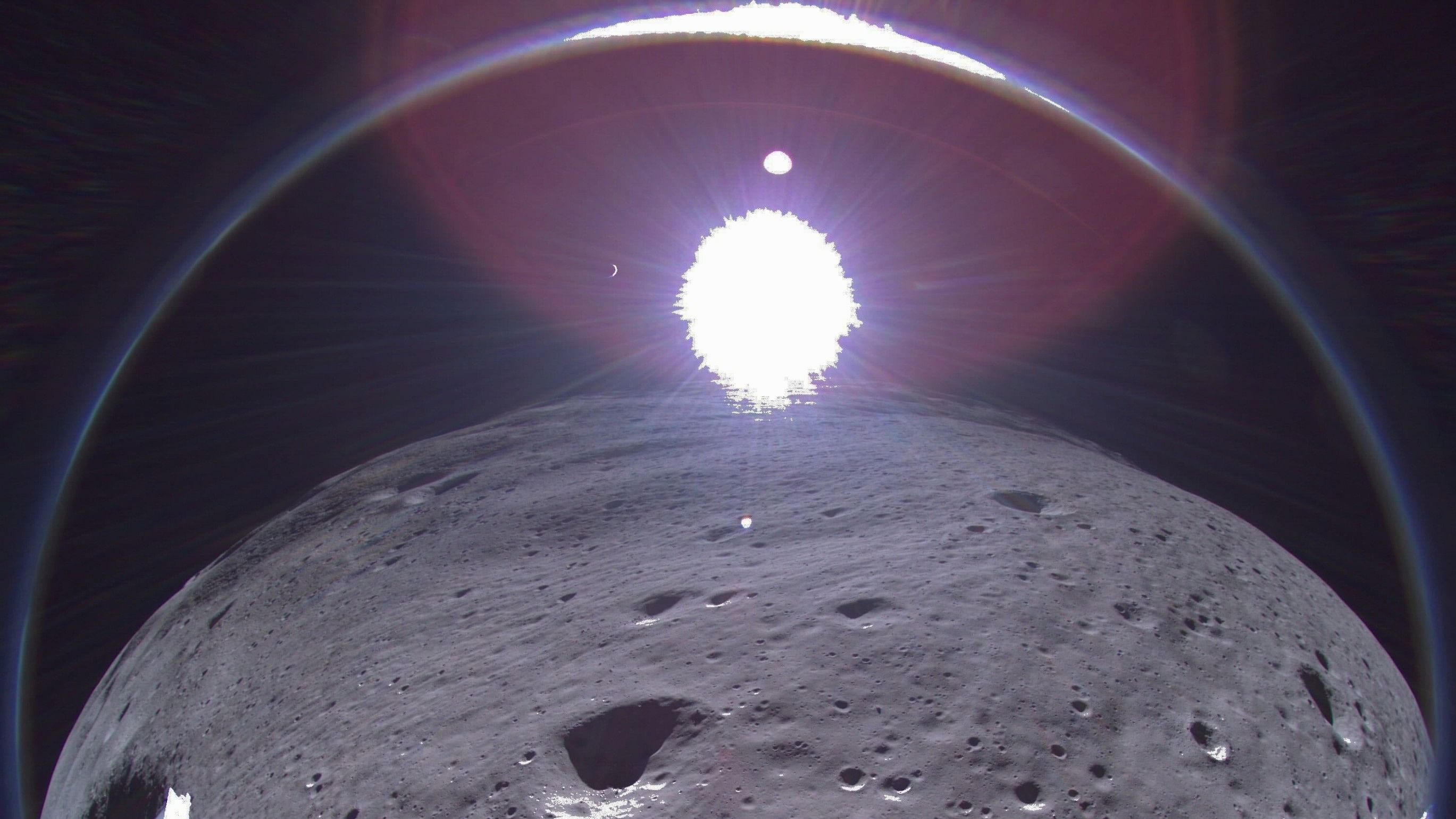
An image from February 22, 2024, transmitted through Odysseus showcases the crescent Earth in the backdrop.
Credit: X/@Int_Machines
While many of us move to the rhythm of Talking to the Moon song by Bruno Mars, the US and Europe space agencies have been making investments in projects to evaluate how Earth's mobile network technologies (4G& 5G) can translate to the moon's environment.
United Kingdom's Goonhilly Earth Station which communicates with spacecrafts and satellites in the space recently received the first signal from Odysseus— the Intuitive Machines spacecraft which was launched on Falcon 9 rocket, on February 15 from NASA's Kennedy Space Center in Florida.
"Intuitive Machines' IM-1 mission was particularly exciting because their next mission, IM-2 in 2025, is also our first opportunity to demonstrate cellular connectivity on the Moon and collect data," BBC quoted Michael Zemba, Nasa’s Lunar Surface Propagation (LSP) principal investigator as saying.
"Nasa has funded Nokia Bell Labs to demonstrate a 4G link from the lander to a rover on that mission, which will be the first cellular network on the Moon and a fantastic opportunity for both model validation and technology demonstration," Zemba added.
The first signal received by Goonhilly confirmed the private US spacecraft's first soft-landing on the lunar surface in over 5 decades. As Odysseus traverses paths on the lunar soil, now, the space experts are accelerating efforts to study the 4G and 5G connectivity— and this needs evaluation of appropriate areas on the moon where all the required apparatus would be taken and installed.
Nasa is launching Moon relay satellites as part of its Lunar Communications Relay and Navigation Systems project. The European Space Agency (Esa) which is a key partner in the Artemis missions has its Moonlight programme.
"We're taking a Nasa laser retro reflector. We're also taking a Global Navigation Satellite System (GNSS) receiver, which will take the furthest measurements of GNSS from Earth to see if we can do some weak signal detection there to get location measurements," said Charles Cranstoun, Lunar Pathfinder's project manager at UK's Survey Satellite Technology (SSTL).
LunarLites at NASA's Glenn Research Centre in Ohio and the LSP are the two ongoing projects that NASA is currently investing into. The LSP is aimed at analyzing how wireless communications systems will perform in the moon's environment.
Another programme called Artemis intends to put astronauts in lunar orbit in 2025, with a crewed landing a year later. NASA is also studying the Shackleton Crater which is two miles deep and 12 miles wide— as this can be one of the potential landing sites for the upcoming missions.
"The Apollo missions all landed near the Moon’s mid-latitudes and mostly around the flat lava plains. For the Artemis campaign, however, our interest lies in exploring the poles of the Moon," pointed Zemba.
He then said that "Shackleton Crater is deeper than the Grand Canyon. Those kinds of extremes at the South Pole present challenges for establishing wireless networks like wi-fi and 5G and that's why it’s critical to have accurate and reliable models and simulation tools. In principle, it's the same idea as picking a good spot for your wi-fi router at home, but with craters bigger than Manhattan."
While establishing communication between Moon and Earth is one of the aspects that NASA is aiming for with mobile network technologies, the transmission of high quality images is also the focus of the projects. "No one is going to accept the Apollo video quality," said Matt Cosby, the chief technology officer at the UK’s Goonhilly Earth Station.
"We will expect 4K resolution from the Moon almost in real time coming from the landing. It's going to be up to 500 megabits of data coming back so the images are going to be 10 times better. In this day and age, and with social media, grainy black and white photos and videos from the Moon's surface will be unacceptable and we need to get the higher frequencies to be able to do that. It's not a huge leap but it needs to be made. It's all about investment," added Cosby.
When and if mobile network technologies are installed on the lunar surface, astronauts will be able to use the 4G and 5G bandwidths to communicate with their rovers, instruments and crew members. A link would be sufficient back on Earth to transmit any data, back to the moon.